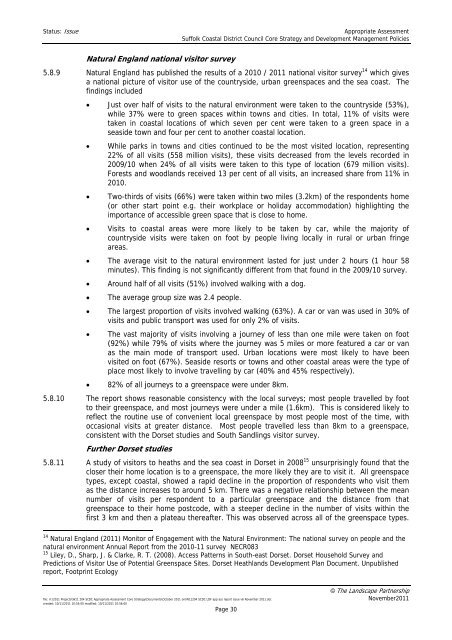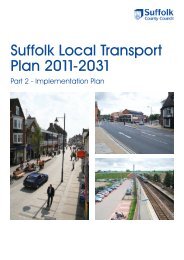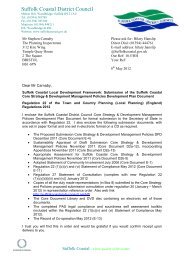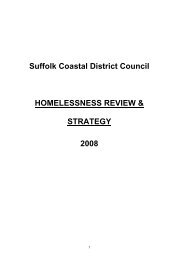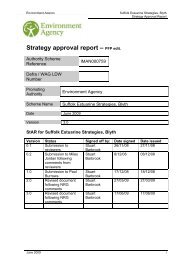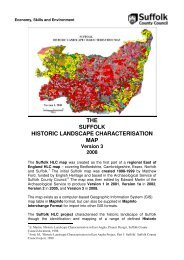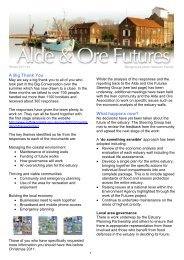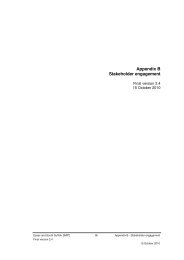natura 2000 standard data form - Suffolk Coastal District Council
natura 2000 standard data form - Suffolk Coastal District Council
natura 2000 standard data form - Suffolk Coastal District Council
You also want an ePaper? Increase the reach of your titles
YUMPU automatically turns print PDFs into web optimized ePapers that Google loves.
Status: Issue Appropriate Assessment<br />
<strong>Suffolk</strong> <strong>Coastal</strong> <strong>District</strong> <strong>Council</strong> Core Strategy and Development Management Policies<br />
Natural England national visitor survey<br />
5.8.9 Natural England has published the results of a 2010 / 2011 national visitor survey 14 which gives<br />
a national picture of visitor use of the countryside, urban greenspaces and the sea coast. The<br />
findings included<br />
• Just over half of visits to the <strong>natura</strong>l environment were taken to the countryside (53%),<br />
while 37% were to green spaces within towns and cities. In total, 11% of visits were<br />
taken in coastal locations of which seven per cent were taken to a green space in a<br />
seaside town and four per cent to another coastal location.<br />
• While parks in towns and cities continued to be the most visited location, representing<br />
22% of all visits (558 million visits), these visits decreased from the levels recorded in<br />
2009/10 when 24% of all visits were taken to this type of location (679 million visits).<br />
Forests and woodlands received 13 per cent of all visits, an increased share from 11% in<br />
2010.<br />
• Two-thirds of visits (66%) were taken within two miles (3.2km) of the respondents home<br />
(or other start point e.g. their workplace or holiday accommodation) highlighting the<br />
importance of accessible green space that is close to home.<br />
• Visits to coastal areas were more likely to be taken by car, while the majority of<br />
countryside visits were taken on foot by people living locally in rural or urban fringe<br />
areas.<br />
• The average visit to the <strong>natura</strong>l environment lasted for just under 2 hours (1 hour 58<br />
minutes). This finding is not significantly different from that found in the 2009/10 survey.<br />
• Around half of all visits (51%) involved walking with a dog.<br />
• The average group size was 2.4 people.<br />
• The largest proportion of visits involved walking (63%). A car or van was used in 30% of<br />
visits and public transport was used for only 2% of visits.<br />
• The vast majority of visits involving a journey of less than one mile were taken on foot<br />
(92%) while 79% of visits where the journey was 5 miles or more featured a car or van<br />
as the main mode of transport used. Urban locations were most likely to have been<br />
visited on foot (67%). Seaside resorts or towns and other coastal areas were the type of<br />
place most likely to involve travelling by car (40% and 45% respectively).<br />
• 82% of all journeys to a greenspace were under 8km.<br />
5.8.10 The report shows reasonable consistency with the local surveys; most people travelled by foot<br />
to their greenspace, and most journeys were under a mile (1.6km). This is considered likely to<br />
reflect the routine use of convenient local greenspace by most people most of the time, with<br />
occasional visits at greater distance. Most people travelled less than 8km to a greenspace,<br />
consistent with the Dorset studies and South Sandlings visitor survey.<br />
Further Dorset studies<br />
5.8.11 A study of visitors to heaths and the sea coast in Dorset in 2008 15 unsurprisingly found that the<br />
closer their home location is to a greenspace, the more likely they are to visit it. All greenspace<br />
types, except coastal, showed a rapid decline in the proportion of respondents who visit them<br />
as the distance increases to around 5 km. There was a negative relationship between the mean<br />
number of visits per respondent to a particular greenspace and the distance from that<br />
greenspace to their home postcode, with a steeper decline in the number of visits within the<br />
first 3 km and then a plateau thereafter. This was observed across all of the greenspace types.<br />
14 Natural England (2011) Monitor of Engagement with the Natural Environment: The national survey on people and the<br />
<strong>natura</strong>l environment Annual Report from the 2010-11 survey NECR083<br />
15 Liley, D., Sharp, J. & Clarke, R. T. (2008). Access Patterns in South-east Dorset. Dorset Household Survey and<br />
Predictions of Visitor Use of Potential Greenspace Sites. Dorset Heathlands Development Plan Document. Unpublished<br />
report, Footprint Ecology<br />
© The Landscape Partnership<br />
file: V:\2011 Projects\W11 204 SCDC Appropriate Assessment Core Strategy\Documents\October 2011 on\W11204 SCDC LDF app ass report issue v6 November 2011.doc November2011<br />
created: 10/11/2011 10:55:00 modified: 10/11/2011 10:56:00<br />
Page 30


